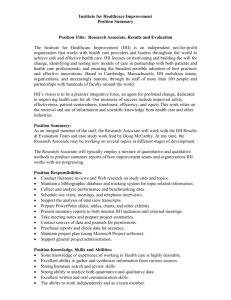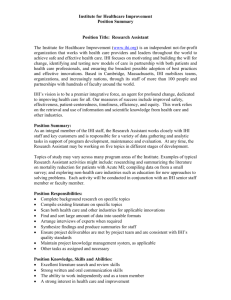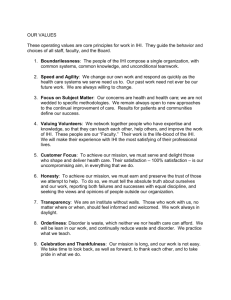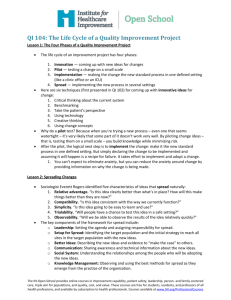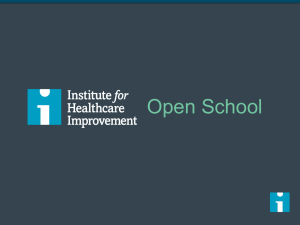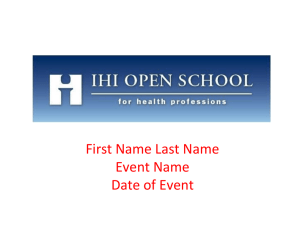Patient Safety & Quality Improvement in GME
advertisement
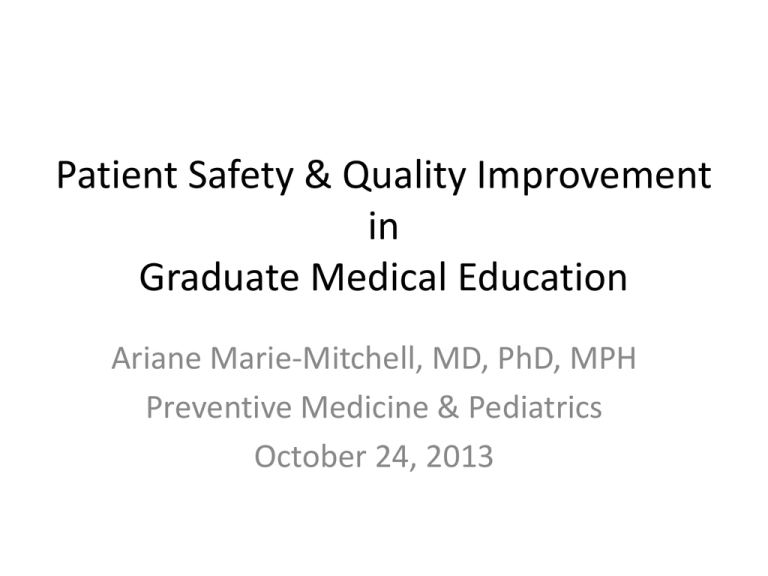
Patient Safety & Quality Improvement in Graduate Medical Education Ariane Marie-Mitchell, MD, PhD, MPH Preventive Medicine & Pediatrics October 24, 2013 OUTLINE I. What do all residents need to know about PSQI II. What resources are available to learn about PSQI III. How can residency programs integrate training in PSQI Training physicians to participate in Quality Improvement is a positive trend in health care. 77% 23% 0% 0% 0% 0% Ag re e ha tA gr ee So Ne m ew ut ra ha l tD isa gr ee D St isa ro gr ng ee ly Di sa gr ee ew So m Ag r ee 0% ly Strongly Agree Agree Somewhat Agree Neutral Somewhat Disagree Disagree Strongly Disagree St ro ng A. B. C. D. E. F. G. Deaths Due to Surgical or Medical Mishaps per 100,000 Population, 2006 0.6 0.6 0.6 0.6 0.5 0.5 0.4 0.4 0.3 0.3 0.2 0.1 0.1 0.0 0.0 France* Germany United United States* Kingdom* * 2005 **2004 Source: OECD Health Data 2008, “June 2008.” Canada** OECD Median Netherlands New Zealand** THE COMMONWEALTH FUND Exhibit ES-1. Overall Ranking Country Rankings 1.00–2.33 2.34–4.66 4.67–7.00 AUS CAN GER NETH NZ UK US OVERALL RANKING (2010) 3 6 4 1 5 2 7 Quality Care 4 7 5 2 1 3 6 Effective Care 2 7 6 3 5 1 4 Safe Care 6 5 3 1 4 2 7 Coordinated Care 4 5 7 2 1 3 6 Patient-Centered Care 2 5 3 6 1 7 4 6.5 5 3 1 4 2 6.5 Cost-Related Problem 6 3.5 3.5 2 5 1 7 Timeliness of Care 6 7 2 1 3 4 5 Efficiency 2 6 5 3 4 1 7 Equity 4 5 3 1 6 2 7 Long, Healthy, Productive Lives 1 2 3 4 5 6 7 $3,357 $3,895 $3,588 $3,837* $2,454 $2,992 $7,290 Access Health Expenditures/Capita, 2007 Note: * Estimate. Expenditures shown in $US PPP (purchasing power parity). Source: Calculated by The Commonwealth Fund based on 2007 International Health Policy Survey; 2008 International Health Policy Survey of Sicker Adults; 2009 International Health Policy Survey of Primary Care Physicians; Commonwealth Fund Commission on a High Performance Health System National Scorecard; and Organization for Economic Cooperation and Development, OECD Health Data, 2009 (Paris: OECD, Nov. 2009). THE COMMONWEALTH FUND PSQI IS ABOUT HOW TO PRACTICE MEDICINE LLUMC Physician Lounge PSQI www.lluphysicianlounge.com/psqi/ • Overview • Faculty • Introduction to PSQI • Advanced Practice of PSQI • Models for Integrating PSQI into GME • Selected References Introduction to PSQI Core Competencies Practice Based Learning and Improvement (how good is my practice?) • Use QI methods to analyze practice and implement changes Systems Based Practice (how good is the health care system?) • Advocate for quality patient care and optimal patient care systems • Work in inter-professional teams to enhance patient safety and improve quality • Participate in identifying system errors • Use QI methods to implement system solutions Introduction to PSQI Learning Objectives Patient Safety • Know the scope of medical errors and main types • Distinguish between error and harm • Use voluntary reporting systems to report errors and near-misses • List key methods for reducing errors • Use key communication skills including SBAR (Situation, Background, Assessment, Recommendation), briefings, read-backs, and CUS (Concerned, Uncomfortable, Safety) • Describe a root cause analysis • Structure an effective apology Introduction to PSQI Learning Objectives Quality Improvement • • • • • • • • • • List six dimensions of quality health care Describe how U.S. health care system compares to others Create a specific aim statement Select outcome, process and balancing measures Select appropriate measures of change Use PDSA (Plan, Do, Study, Act) cycles List key differences between QI and research Understand basics of sampling methods for QI Create and use key QI tools Understand the basics of spread and diffusion Does your program require residents to complete any IHI Open School Modules during training?50% 17% Co n sid er in g No 17% 17% Do n’ tk no w Yes No Considering Don’t know Ye s A. B. C. D. Does your program require residents to participate in an Improvement Project using QI methods? 73% Yes No Considering Don’t know 18% 9% Do n’ tk no w Co n sid er in g No 0% Ye s A. B. C. D. My program has enough faculty to mentor residents on an Improvement Project using QI methods. 29% 21% 21% 14% 7% 7% Ag re e ha tA gr ee So Ne m ew ut ra ha l tD isa gr ee D St isa ro gr ng ee ly Di sa gr ee ew So m Ag r ee 0% ly Strongly Agree Agree Somewhat Agree Neutral Somewhat Disagree Disagree Strongly Disagree St ro ng A. B. C. D. E. F. G. Introduction to PSQI Online Learning IHI Open School (Institute for Healthcare Improvement) • Patient Safety – 101-105 meet objectives or ~6 hours (2 required pre-intern) • Quality Improvement- 101-104 meet objectives or ~4 hours Alternatives • Mayo Clinic Quality Academy • AMA Introduction to Practice of Medicine Introduction to PSQI Didactics See “Selected References- PSQI Education” • WHO Patient Safety Curriculum • University of Chicago Medical Center Internal Medicine Quality Curriculum Introduction to PSQI Practice-Based Learning Project Key Steps • • • • • • • • #1 Identify a Faculty Mentor #2 Describe your Professional Opportunity #3 State your Aim #4 Diagram a Cause-Effect Analysis #5 Define your Measures #6 Conduct an Evidence Review #7 Collect Baseline Data #8 Test a Change (repeat tests until outcome achieved) Improvement Projects Practice-Based Learning • Data source = your patient encounters • Change focuses on your practice behaviors Systems-Based Practice • Data source = your clinical microsystem • Change requires team effort Describe Cause-Effect Analysis Use Evidence Collect and Study Data Test Changes PBL Project Example • Professional Opportunity: Underuse of influenza vaccination in my adult patients • Aim Statement: “I will increase my influenza vaccinations rate to 80% in my eligible adult patients age 18-64 by December 30, 2013” • Evidence Review: ACIP Vaccine Recommendations for 2013 PBL Project Example: Cause-Effect Diagram Patients Physician I know the guidelines I remember to order Declined _Contraindicated Insurance coverage Vaccine availability Vaccine Record_ Nurse Schedule Materials Processes I effectively counsel Influenza Vaccination Rate PBL Project Example (cont’d) • Outcome measure = # patients age 18-64 who received influenza vaccination / total # eligible patients age 18-64 seen during time period • Process measures = – Proportion missed opportunities to order – Proportion orders declined • Balancing measures = – Proportion patient complaints re: billing PBL Worksheet LET’S PRACTICE: 1. Obtain a PBL Worksheet at your table 2. Draft items #2-5 3. Discuss with others at your table TIME ~ 10 minutes How many total hours are dedicated in your current curriculum to learning PSQI? 38% 25% 25% .. ep or rm ur o ho Ab ou t1 1 th an or e M pe rm ... on .. ho ur 1 ho ur so ha n Le ss t ny (a No ne pe rm ut sid ... 13% PS QI i A. None (any PSQI is outside regular work hours) B. Less than 1 hour per month (<12 hours per year) C. More than 1 hour per month but <1 hour per week D. About 1 hour or more per week Models for Integrating PSQI into GME Pre-Residency Model • Complete IHI Open School Certification Intern Model • Complete IHI Open School Certification OR monthly didactics • Improvement Project, conducted by small groups, mentored by faculty from clinic during monthly meetings • Improvement Project final presentations at Grand Rounds Models for Integrating PSQI into GME One Block Model PGY1/PGY2 • Complete IHI Open School Certification OR monthly didactics PGY3 • One month long rotation including ~24 hours of scheduled time – Didactic sessions related to PSQI – Review and presentation of patient cases at quality assurance or mortality review committee meetings – Serve as auditors in bi-weekly hospital wide Joint Commission Accreditation mock surveys – Improvement Project, identified and completed by individual residents, presented at end of month OR year Models for Integrating PSQI into GME Two Block Model PGY2 e.g. during 2 months of ambulatory care • Weekly meetings for didactics or development of Improvement Project- first PDSA cycle PGY3 e.g. during 2 months of ambulatory care • Weekly meetings for didactics or continuation of Improvement Project- second PDSA cycle Models for Integrating PSQI into GME Longitudinal Model PGY1: • IHI Patient Safety modules and Readings • PBL Project, conducted over 6 months, mentored by faculty, presented by individual residents at noon conference PGY2: • IHI Quality Improvement modules and Readings • SBP Project, join existing team and conduct over 12 months, mentored by faculty, presented by group at Grand Rounds at end of the year PGY3: • IHI Quality Improvement/Leadership modules and Readings • SBP Project, lead QI team over 12 months, mentored by faculty, presented by group at Grand Rounds at end of the year SUMMARY • See our PSQI website www.lluphysicianlounge.com/psqi/ – Learning Objectives – Online Resources – Project Guidance – Models for Integrating PSQI into GME • Encourage senior residents to participate in the Advanced Practice of PSQI Concentration The one thing to teach about PSQI Physician participation in Patient Safety and Quality Improvement initiatives… is Good Medicine

